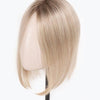What to Know About Wigs for Beginners: Your Ultimate Guide

What to Know About Wigs for Beginners: Your Ultimate Guide
Wigs have been a staple in the world of fashion, beauty, and self-expression for centuries. Whether you're looking to change up your hairstyle, try out a new look, or simply deal with hair loss, wigs can be a fantastic solution. If you're a beginner in the world of wigs, you've come to the right place. In this comprehensive guide, we'll explore everything you need to know about wigs to help you embark on your wig-wearing journey with confidence.
The image above is one of lovely customers wearing Angelica Part Monofilament Plumberry Jam LR.
1. Types of Wigs
Wigs come in various styles and materials, and understanding the different types is crucial for beginners:
a. Synthetic Wigs: These are made from synthetic fibers and are more budget-friendly. They come in a wide range of styles and colors but may have a less natural appearance compared to human hair wigs.
b. Human Hair Wigs: These wigs are made from real human hair and offer a more natural look and feel. They are also more customizable, allowing for heat styling and color changes.
c. Lace Front Wigs: These wigs have a fine lace front that mimics the appearance of a natural hairline. They are popular for their realistic look and versatility.
2. Wig Cap Construction
Understanding the cap construction of wigs is essential for comfort and fit, more information here.
a. Wefted Wigs: These wigs are fully machine made and priced economically, making them a good choice for beginners.
b. Monofilament Wigs: They have a fine mesh cap that mimics the appearance of the scalp, providing a more natural look and allowing for parting in different directions.
c. Hand-Tied Wigs: These wigs have individual hairs hand-tied to the cap, offering the most realistic movement and appearance.
3. Wig Sizing
Getting the right fit is crucial for a comfortable and natural-looking wig. Measure your head circumference and consult the wig manufacturer's size chart to find the right size.
How to measure your head
4. Wig Care and Maintenance
Proper care and maintenance are essential to extend the life of your wig, check this out how to Fight the Frizz.
a. Washing: Use wig-specific shampoos and conditioners, and follow the manufacturer's instructions for washing frequency. More information here.
b. Styling: Be cautious when using heat styling tools on synthetic wigs, as they can melt. Human hair wigs can be styled with heat, but it's essential to use a heat protectant.
c. Storage: Store your wig on a wig stand or in a breathable bag to maintain its shape and prevent tangling. More information here.
d. Wig Accessories: Invest in wig brushes, combs, and styling products designed for wigs to keep them looking their best.
5. Wig Application
Learning how to put on and secure your wig is a crucial skill for beginners. You can use wig caps, adhesive tapes, or wig grips to ensure a secure fit.
6. Wig Styling Tips
Experiment with different styles, cuts, and colors to find the look that suits you best. You can also seek professional help for customizing your wig to your preferences.
7. Wig Confidence
Remember that wearing a wig is a personal choice, and confidence is key. Embrace your new look with pride and enjoy the versatility that wigs offer.
Conclusion
Wearing wigs can be a fun and empowering experience, whether you're exploring new styles or dealing with hair loss. As a beginner, understanding the different types of wigs, cap constructions, sizing, care, and styling tips is essential for a successful wig-wearing journey. With the right knowledge and a bit of practice, you can confidently rock any wig style and express your unique personality. So, go ahead and embrace the world of wigs, and let your hair (or wig) down with style!
-
Posted in
Wig Type







